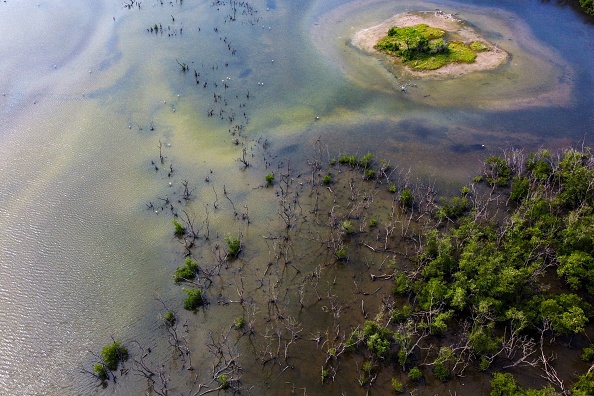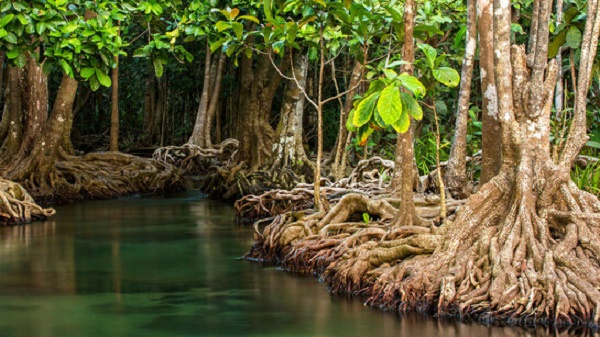FEATURED STORY
CONFERENCE ALERT MMM6. Colombia. 24th – 28th July. Call for abstracts  GLOBAL – MMM6 is currently inviting submissions of abstracts for oral and poster presentations. The sixth Mangrove Macrobenthos and Management conference (MMM6): “Mangrove Ecosystems for Human Well-being in a Changing Planet” is bringing together stakeholders from different sectors of society from many countries across the five continents in a single forum to present and discuss research advances and proposals for the conservation and management of mangrove forests, as well as to advocate for mangroves as Nature-based Solutions to climate change. MMM6 is the first conference of the series to be held in Latin America and the Caribbean, a neotropical region where mangroves have evolved among some of the most biodiverse tropical forests in the world. In particular, mangroves in Colombia are found in both the Caribbean and the Tropical Eastern Pacific Marine Ecoregions. The Mangrove Macrobenthos and Management (MMM) conference series is the world’s largest gathering of researchers and practitioners dedicated to the science and conservation of mangrove ecosystems. Presenters will have 12 minutes to give their talks and 3 minutes for questions. The total allotted time per speaker is 15 minutes. MMM6 features 3 poster sessions: Monday, Tuesday, and Thursday nights. Poster dimensions: 90cm width x 120cm height. With the aim of harmonizing global initiatives, the topics selected for the MMM6 conference correspond to the Ocean Decade Challenges for collective impact of United Nations. READ MORE GLOBAL Mangroves Dubbed Voracious Shoreline Guardians

GLOBAL – Mangroves are salt-tolerant shrubs that thrive in the harshest conditions. Still, new UniSA research shows that they are also avid coastal protectors, capable of surviving in heavily metal-contaminated environments. The researchers discovered that grey mangroves (Avicennia marina) can withstand high levels of lead, zinc, arsenic, cadmium, and copper in contaminated sediment without suffering adverse health effects. The health of the grey mangroves close to the Port Pirie smelter was the subject of the study. Mangroves were found to be unaffected by metallic contaminants when leaf chlorophyl content was used as a proxy for plant health, despite lead and zinc levels being 60 and 151-fold higher than regulatory guidance values. The findings emphasize the critical role of mangroves in stabilizing polluted areas and the importance of protecting these “coastal guardians” around the world. READ MORE AFRICA Travelling theatre presents pollution to Coastal fisherfolk

KENYA – Art mirrors society, reflecting our actions and natural phenomena. So, what do creatives do when the oceans rebel? This is what is going on with in the world today. Climate change and marine pollution are affecting life on earth negatively, and there are communities that are impacted and don’t understand why. Kenyan artiste Caroline Ngorobi, 37, has decided to break down the climate and pollution issues to Kenyan coastal communities. Ngorobi is the creative director at Jukwaa Arts, a Mombasa-based creative arts group using theatre in education to deal with modern day problems. In her latest project, a festival dubbed Bahari Huru, Swahili for ‘’free oceans,’’ Ngorobi, tells stories on the importance of marine conservation to provoke conversations on how pollution happens, who pollutes, why and what solutions communities can offer to avoid more pitfalls. READ MORE Institute National Action Plan to Protect Peatlands, Mangroves

GHANA -Mr Muntaka Chasant, a researcher and climate change activist, has suggested to the government to consider instituting a national action plan to protect Ghana’s peatlands and mangrove ecosystems as a nature-based solution to climate change. “It is important the government considers an action plan to protect peatlands, mangroves mitigate climate change,” he said. Mr Chasant who was speaker at the back of the just ended COP 27 held on from November 6 -18, 2022, in Sharm el-Sheikh, Egypt, repeated his appeal he made prior to the meeting, saying such a national action plan should address sustainable use and protection of peatlands and mangrove habitats for the longer term. “Unprotected, the vast peat swamp forests around Nzema are under anthropogenic pressures. They are under threat from oil and gas activities and land-use change, including logging and drainage for agriculture,” he said. According to the Climate Change activist, those practices shifted the carbon-rich forests from net carbon sinks to net carbon sources — meaning more carbon are leaving than being brought in. Referring to mangrove deforestation, Mr Chasant drew the government’s attention to the degradation of mangrove habitats in the Ankobra River and Volta Delta through illegal mining (galamsey), making a case for an urgent national policy that would protect mangroves as well. READ MORE Mangrove forests won’t be able to spread further in South Africa, so protecting them is crucial

SOUTH AFRICA – Mangroves are valuable assets as ecosystems because they are able to store more carbon than terrestrial ecosystems and they support a significant amount of biodiversity. Mangroves won’t grow in cool climates. In the northern hemisphere, their range ends at areas where it snows in winter. But, even though the coasts of places like Brazil, Australia and South Africa don’t get freeze events, mangroves still stop occurring at a certain latitude in the southern hemisphere. We wanted to know why this is the case and to determine whether there are other areas along South Africa’s coast that are climatically suitable for mangroves but where the forests don’t grow. We also wondered, since climate change will make some parts of the world warmer in the coming years and decades, whether mangroves might in future be able to grow in parts of South Africa where they’re not found now. Finally, we wanted to understand whether climate change will make areas in South Africa where mangroves currently exist unsuitable for the forests in future. Our new study reveals the answers. READ MORE Eco heroes recognised for saving Beachwood Mangroves Nature Reserve

SOUTH AFRICA – This year, Durban came close to losing a portion of the Beachwood Mangroves Nature Reserve. Heavy sea swells and storm surges wreaked havoc on the 76-hectare reserve, posing a threat to its wildlife and its mangroves (black and white mangroves). The movement to save the reserve led to the formation of a Multi-Agency Task Team (MATT) project which included various stakeholders Environmental organisation, Oceans Alive, alongside the eThekwini Municipality, the South African Association for Marine Biological Research (SAAMBR), Council for Scientific and Industrial Research (CSIR), The Oceanographic Research Institute (ORI), the North Durban Honorary Officers and Ezemvelo KZN Wildlife came together to save the mangroves. Over the course of several days, plans were set in motion to open up the creek to the reserve that had been covered in sand to recreate the inter-tidal relationship with the Umgeni River. Teichmann Civils and Morgado Plant Hire provided the earth-moving equipment while Marshall Security provided the security. Recently, the honorary officers held an appreciation lunch for all the roleplayers involved in the project to save the reserve. Many of those involved in the project received a plaque of appreciation and a certificate recognising their efforts, including Tim Baker, a drone pilot, who helped with aerial footage of the rescue operation. READ MORE ASIA Coal Power Plant Opens Near Mangrove Forest

BANGLADESH – Bangladesh will soon begin burning coal at a large power station near the world’s largest mangrove forest. The country often experiences power failures and blackouts. The government expects the new power factory to increase electric power dependability. But, environmentalists say there are cleaner sources of energy the country should use instead of burning coal. The station will produce about 1,300 megawatts of power, as much as Bangladesh’s largest coal power plant produces. The new power station will burn about 4.7 million tons of coal. It will release close to 15 million tons of carbon dioxide waste gas each year. Carbon dioxide emissions cause the planet to warm. About 12,000 tons of coal will be shipped by boat through the mangrove forest, called the Sundarbans, each day. Sundarbans means “beautiful forest” in Bengali. The coastal area of trees developed over thousands of years. The Ganga, Brahmaputra, and Meghna rivers flow through the area, rich with sediment that helps the forest grow. Some environmentalists, scientists and people who live in the area worry that pollution from the new factory will damage the Sundarbans ecosystem. READ MORE The Moi struggle for land rights

NEW GUINNEA – On the ground and in the courts, members of the Moi indigenous group are resisting oil palm expansion in West Papua, Indonesia. At the northwestern tip of New Guinea, mangroves line rivers that wind their way through densely forested islands and capes. Mangrove roots sink into the water, providing a home for crabs, shrimp and shellfish, which filter water for snapper and shark. Higher up the riverbanks, deer, boar, birds of paradise and tree kangaroos live among sago palms and old-growth trees. “No artist can bring to life so many trees. No one can create a river or plant mangroves as beautiful as this, with all the creatures that live within,” says Yance Nibra, head of Segun district in the Sorong regency of West Papua province, Indonesia. “It’s beautiful, but it won’t be like this soon,” Yance says, as our boat passes a concrete pillar marked with the name of an oil palm company. “We’ve entered the company’s concession area.” Yance, his family and ancestors are part of the Moi indigenous group, who are spread across Sorong’s forests and towns. When he was an official in a neighbouring district, he witnessed the damage an oil palm plantation can bring, with cleared land leaching silt into rivers and pesticides infecting the air and water. That plantation has been linked to the Fangiono family, which has ranked among Indonesia’s largest deforesters in the last few years. READ MORE Study launched on golden jackals in city’s mangrove patches

INDIA – Amongst the wild canidae found in India, golden jackals are the most widespread species, occupying varied habitat types ranging from forests and grasslands to agricultural landscapes. The mangrove ecosystem is one unique habitat used by golden jackals. A first-of-its-kind scientific research study on the golden jackal and other small carnivores in the Mumbai Metropolitan Region (MMR) has been initiated in a collaboration between the Mangrove and Marine Biodiversity Conservation Foundation of Maharashtra and the Wildlife Conservation Society-India. Titled ‘Baseline survey on golden jackal distribution in the Mumbai Metropolitan Region’, the study will be conducted between December 2022 and June 2023 in different phases covering mangrove forest patches at the Thane Creek flamingo sanctuary and in Central, Western and Navi Mumbai. The objective of the study is to document their presence and that of other small carnivores in this habitat by using sign surveys and remotely triggered camera traps. After initial reconnaissance surveys conducted during the first two months, the research team will finalise suitable methods and techniques to document and study the small-carnivore ecology from this habitat. READ MORE Plan to save mangroves must translate into action

INDIA – A senior official tweeted about action against land-grabbers, stating that 103 hutments in mangrove areas had been cleared out. There has been the uncovering of a massive land-grab racket in Navi Mumbai’s mangrove zones, and environmentalists have urged the forest department to expedite plans to install 111 CCTV cameras at nearly 20 locations in the area. The department’s Mangrove Cell has said that it has uncovered a racket involving the killing of over 17,240 mangrove plants and usurping around 3.88 hectares of land at Vashi and Turbhe. A senior official tweeted about action against land-grabbers, stating that 103 hutments in mangrove areas had been cleared out. We join the environmentalists in their demand for electronic eyes on the ground. Widespread surveillance is a powerful weapon and has to be installed both for pre-encroachment action, to serve as a deterrent, and action to nab those responsible and even those complicit if the land has been usurped. With every inch of green cover being precious, we need to safeguard trees and open spaces with zeal. Officials are responsible for tackling encroachment. Citizens, including activists, are vigilantes and must be alert to threats of takeovers. And electronic aids can complete this effort. READ MORE
Like this newsletter?
 Pease consider donating to MAP to keep it going.
Giving could never be easier  *Articles in this newsletter may mention practices being used and/or show exagerated results being claimed without proof. Stories are presented here in effort to show mangrove related activity around the world and do not necessarily reflect Mangrove Action Project’s views or mangrove restoration best-practices. | NOTICE 
Conference alert. MMM6. Colombia. 24th – 28th July. Call for abstracts
MMM6 is currently inviting submissions of abstracts for oral and poster presentations. READ MORE
ACTION ALERTS DON’T LET THE PACIFIC ISLANDS SINK!Climate change is drowning the Pacific Islands. Join the urgent call from the Prime Minister of Tuvalu and sign with your email address: CLICK HERE Do not sacrifice Congo’s rainforests to the oil industry! TAKE ACTION TAKE MAP SURVEY Please see the survey questionnaire we at MAP put together to discover where the shrimp industry is still having major adverse effects on mangroves and local communities.
TAKE THE SURVEY Stop the Dredging – 6.7 million cubic meters of sand from the Addu atoll basin will destroy nature, biodiversity and the natural defences and resilience of this UNESCO Biosphere Reserve. SIGN THE PETITION Keep fossil fuels out of Bangladesh for the health and wellbeing of the local communities, the beautiful regional beaches and forests, the Bangladeshi economy, and our shared climate. SIGN PETITION Stop this total madness Stop the biggest heated oil pipeline in the world — right through the heart of Africa!
CLICK HERE
Like this newsletter? Pease consider donating to MAP to keep it going. Giving could never be easier 
MAP Website en Español
haga clic aqui 13 Year old Linda Li “Mangrove Adventure” from Kid Dream Art School

WATCH NOW 
Restoring The Natural Mangrove Forest
Watch movie

Community Based Ecological Mangrove Restoration in Rufiji Delta VIEW VIDEO
Video: Mangroves for the Future
View Here WANT TO GET INVOLVED?
Follow and Join MAP!    
Like this newsletter? Pease consider donating to MAP to keep it going. Giving could never be easier 

Interested in connecting or working with MAP? Check out our opportunities here 
MANGROVE ISSUES Want to learn more about mangroves?
Our short presentation will give you a better understanding of the issues we are working to solve. WATCH PRESENTATION What is CBEMR? Download MAP’s 2 page CBEMR Information Sheet containing links to all MAP’s CBEMR resources – CLICK HERE View MAP’s uploaded Videos at
MAP Video Gallery Question Your Shrimp Consumer/Markets Campaign!
WATCH VIDEO Mangroves: Guidebook to Malaysia – Click Here SHARE MAP’S VISION
CLICK HERE to watch short introductory video. Together we can work “at the roots of the sea”. Our short documentary, Reducing the Risk of Disaster through Nature-Based Solutions : Mangroves 
NASA Study Maps the Roots of Global Mangrove Loss

Marvellous Mangroves Curriculum The Marvellous Mangroves Curriculum begins with a simple philosophy – getting future generations to not only learn about, but understand the importance of mangrove forests. VISIT 
The award-winning Marvellous Mangroves (MM) curriculum educates children on the importance of mangroves and their ecological functions, teaching them about modern challenges and mechanisms for sustainability. VIEW VIDEO Marvellous Mangroves Curriculum in Bangladesh – WATCH VIDEO
MARVELLOUS MANGROVES IN BRAZIL
En Portuges 
Marvellous Mangroves – A Curriculum-Based Teachers Guide.
Like this newsletter? Pease consider donating to MAP to keep it going. Giving could never be easier 
“Question Your Shrimp” Campaign Question Your Shrimp – is it really sustainable? Sign the Petition
Note to Our Readers: We strive to keep active links in our newsletter. However, due to circumstances beyond our control, occasionally links to stories may become broken. If you find a link to a story is not functioning, please cut and paste the headline into your browser search bar. In most cases you should be able to locate the original story.
Not yet a MAP News subscriber?
Click here to subscribe. 
*Articles in this newsletter may mention practices being used and/or show exagerated results being claimed without proof. Stories are presented here in effort to show mangrove related activity around the world and do not necessarily reflect Mangrove Action Project’s views or mangrove restoration best-practices.
|



























